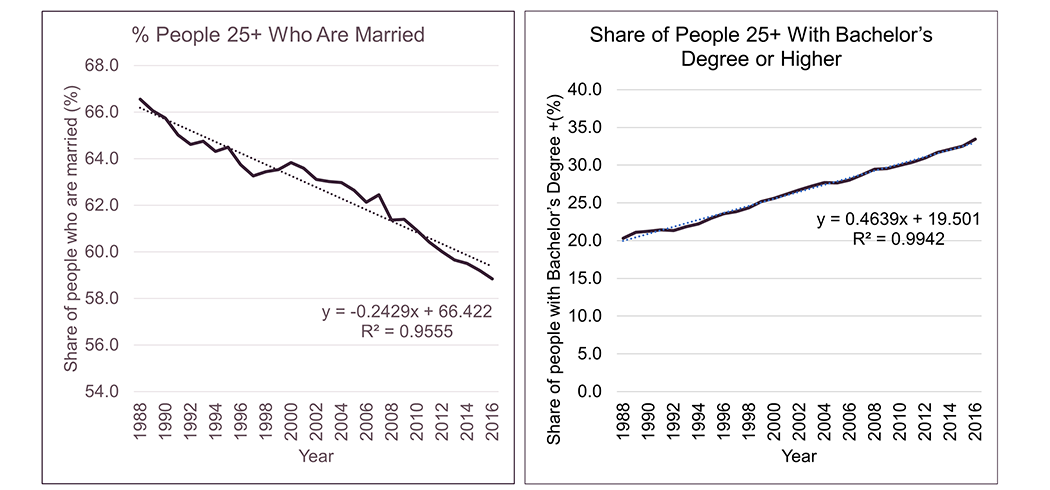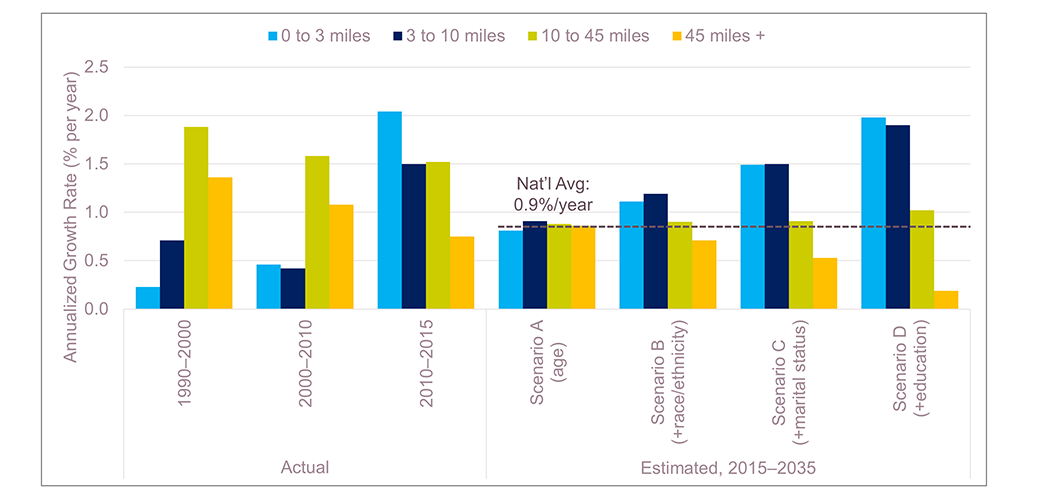Millennials and the Future Urban Landscape
As they age, will the young, white, well-educated, upper income adults who have driven much of the population growth and demographic changes in urban areas continue to live in those places? Or are they likely to move to farther flung suburban locations? And how will a gradually changing demographic makeup affect the geographic population distribution?
In “Are Millennials Coming to Town? The Determinants of Location Choice of Young Adults,” published earlier this year in Urban Affairs Review, I examined these questions. The findings suggest that, while many factors influence residential location choices, demographic and socio-economic trends will contribute to continued growth of urban centers, and that over the next two decades, those centers will grow faster than nearby suburbs and the nation as a whole.
I reached this conclusion via a straightforward two-step method. Using a multinomial logit (MNL) model and data from the decennial censuses of 1990 and 2000 and the American Community Survey of 2010 and 2015, I examined whether there are generational differences in residential location. I found that individuals who are young, persons of color, immigrants, unmarried, and college graduates tend to choose city centers over suburbs, controlling for other factors. In addition, I found that racial and ethnic diversity, delayed marriage, and higher educational levels explain millennials’ inclination to choose city center over suburbs.
To simulate the expected change in the population distribution, I then applied the model’s estimates of locational decisions to the projected population in 2035. This approach allowed me to not only account for changes in the population’s likely age structure but also to account for how growing racial and ethnic diversity, declining rate of marriage, and rising educational attainment might affect future locational decisions. Notably, I assumed that long-term trends in both the marriage rate and educational attainment, which have been consistent in the recent three decades, would continue until at least 2035 (Figure 1).
FIGURE 1. CHANGES IN THE SHARE OF PEOPLE 25 AND OVER WHO ARE MARRIED AND THE SHARE OF PEOPLE WITH BACHELOR’S DEGREE OR HIGHER, 1988–2016
Source: Author’s analysis based on the 1976–2016 Current Population Survey
In my first simulation, I considered how the total population would grow in urban and suburban locations, given just the projected changes in age structure of the adult population (See Scenario A in Figure 2). Then I sequentially took into account how predicted changes in racial and ethnic composition, the marriage rate, and educational attainment are likely to affect those population projections. (See Scenarios B, C, and D in Figure 2).
FIGURE 2. ACTUAL AND ESTIMATED ANNUALIZED POPULATION GROWTH RATES (%), 25 YEARS OLD AND ABOVE
Note: The actual population distribution and growth rates are based on the 1990 and 2000 Census 5% PUMS and 2009 and 2015 American Community Survey 1-year PUMS files. The simulated numbers are from author’s analysis based on the 2017 National Population Projections and 1988–2016 Current Population Survey, Annual Social and Economic Supplement.
Consistent with the “peak” millennial hypothesis (which posits that while three reinforcing cycles – demographic, labor, and housing – combined to maximize millennial’s presence in core urban areas before 2010 and that those same cycles will combine to reduce the urban concentration of young adults by 2020), the results of Scenario A indicate that there would be modest declines in the share of people living in downtown neighborhoods. Moreover, it also indicates that all areas would grow at about the same rate, a pattern that would be different from both the 1990s and 2000s (when suburban areas grew more rapidly than urban ones), and from 2010-2015 (when that pattern was reversed).
However, different pattern emerges in Scenarios B, C, and D, when the long-term trends in racial/ethnic composition, marriage, and educational attainment are incorporated into the model. These simulations produce results in which core urban and inner-city areas will grow faster than suburban areas and the nation as a whole. Moreover, each additional factor increases the urban growth rate and reduces the growth rate in the farthest flung suburban areas.
These findings indicate that while downtown areas will continue to grow, racial and ethnic diversity, delayed or non-marriage, and higher educational attainment, not the aging of millennials and post-millennials, will be the key drivers behind the continued demand for downtown living. While such projections reflect recent trends, actual outcomes in specific cities will be driven by other factors, most notably whether and how those places respond to the increased demand for housing in and near the dense urban core. It will therefore be planners, policymakers, developers, and citizens who will determine the fate of urban centers and, hopefully, leverage these demographic and socio-economic trends to create a path to more healthy, sustainable, and livable cities.



